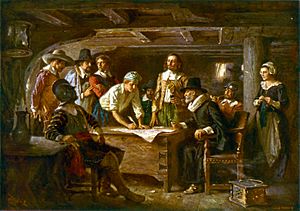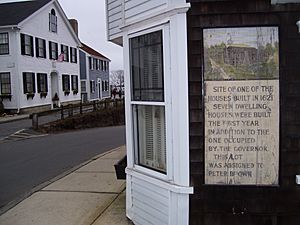Peter Browne facts for kids
Peter Browne was a passenger on the famous ship Mayflower. He was also one of the people who signed the Mayflower Compact, an important agreement for the new colony. Peter was born around 1594 in Dorking, England. This was the same town where another Mayflower passenger, William Mullins, lived.
The Mayflower's Big Trip
Peter Browne was about 25 years old when he boarded the Mayflower in 1620. He traveled with the Mullins family. Sadly, the Mullins family died soon after they arrived in the New World.
The Mayflower left Plymouth, England, on September 16, 1620. There were 102 passengers and about 30 to 40 crew members. On November 19, 1620, the Mayflower finally saw land.
The ship was supposed to land in the Colony of Virginia. However, the Mayflower was too damaged from the long journey. They had to land at Cape Cod, which is now called Provincetown Harbor. They arrived there on November 21. Before leaving the ship, the passengers wrote the Mayflower Compact. This document created rules for how they would live and treat each other in their new home.
Life in Plymouth Colony
An Adventure in the Forest An interesting event happened to Peter Browne in January 1621. This was while the Pilgrims were building their new settlement in Plymouth. On January 12, Peter Browne, John Goodman, and other men went into the forest. They were looking for thatch to use for their roofs.
Around noon, Browne and Goodman walked deeper into the forest. The other men stayed behind to gather the thatch. When the others realized Browne and Goodman were missing, they went back to the settlement. About 10 to 12 men then went to search for them.
It turned out that Browne and Goodman were eating lunch when their dogs started chasing a deer. Soon, the two men got lost. Records say they walked all afternoon. They got wet, and it became very cold at night. They had no weapons, only one sickle each.
That night, they thought they heard lions in the forest. They quickly climbed a tree for shelter. They stayed near the tree all night, ready to escape if needed. The next day, they climbed the highest hill they could find. From there, they could see where they were and find their way back to the colony. Browne and Goodman finally arrived in Plymouth. They were very cold, had frostbite, and were tired and hungry. This was their first time exploring the deep forest in New England.
Peter Browne's Home and Family In the Plymouth settlement of 1620, Peter Browne's house was close to the harbor. It was on the south side of the village street, near John Goodman's home.
In 1623, land was divided among the settlers. As a single man, Peter Browne received one "acre" of land near a brook. His name was written as "Peter Browen" in that record.
Sometime after this land division, Peter married Martha Ford. She was a widow who arrived in November 1621 on a ship called the Fortune. She was the only woman recorded on that ship.
By 1627, Peter and Martha had a daughter named Mary. Martha was also expecting another daughter, Priscilla.
Martha died around 1630. Peter Browne then married again and had two more children.
Peter Browne became sick and died in 1633. He and his first wife, Martha, were buried at Burial Hill in Plymouth.
- George Ernest Bowman (1920). The Mayflower Compact and its signers, (Boston: Massachusetts Society of Mayflower Descendants, 1920). Photocopies of the 1622, 1646 and 1669 versions of the document




